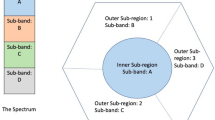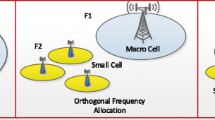Abstract
The small cell structure in which many cells are arranged per unit area by reducing the size of cells is a candidate technology for an increase in transmission capacity in the 5G environment. However, the decrease in the size of the cell led to additional problems such as increased inter cell interference and frequent cell changes owing to the movement of the terminal. Therefore, the aim of this study was to propose small cell dynamic channel allocation (SDCA) and hybrid and dynamic channel allocation (HDCA) using conventional reuse methods to improve the macro cell performance while efficiently utilizing scarce frequency resources. The proposed method facilitates an improved performance that is lacking for macro-cell users in the center area of the cell boundary for the network where conventional macro cells and small cells are superposed. Furthermore, to improve the performance, it can provide resources that are lacking in the small cells of the center. To evaluate the performance, the proposed method was compared to frequency reuse factor1 (FRF1), frequency reuse factor3 (FRF3), and fractional frequency reuse (FFR) methods in terms of the signal-to-interference/noise-ratio (SINR) of users of each macro cell and small cell, outage, capacity for each user, and total system capacity. As a result of comparing the SINR, it was confirmed that the performance of the macro cell users has improved by an average of 43.88% compared to FRF1, FRF3, and FFR, and the performance of small cell users has improved by an average of 4.31%. Comparison results show that the outage proportions of the macro and small cell users are 61.29% and 70.59% lower on average, respectively. A comparison of results show that the capacities of the macro and small cell users have also improved by 22.5% and 14.5% on average, respectively. As the comparison results of the total system capacity indicate, the proposed method shows an average improvement of 11.67%. In cases in which the added resources of the small cells are found to be unnecessary based on the results of the performance evaluation, there is an advantage in that they can be reduced to improve the performance of macro cell users, or they can be used to fill the insufficient resources of the small cells while maintaining the performance of the macro cell users. This fluidity originates from the ability to address occasional situations in a dense environment. These two approaches are expected to be used effectively in 5G network environments.














































Similar content being viewed by others
Change history
25 October 2022
This article has been retracted. Please see the Retraction Notice for more detail: https://doi.org/10.1007/s11235-022-00962-7
References
Cisco. (2020). Annual Internet Report (2018–2023) White Paper. March, 9.
Bartoli, G., Marabissi, D., Pucci, R., & Ronga, L. S. (2017). AI based network and radio resource management in 5G HetNets. Journal of Signal Processing Systems, 89(1), 133–143. https://doi.org/10.1007/s11265-017-1223-0
https://www.ramonmillan.com/documentos/bibliografia/5GUseCases_Nokia.pdf
Moon, J. M., Bahg, Y. J., Hwang, H. Y., & Na, J. H. (2018). Trend of 5G NR based open small cell technologies. Electronics and Telecommunications Trends, 33(5), 33–41. https://doi.org/10.22648/ETRI.2018.J.330504
Elbayoumi, M., Kamel, M., Hamouda, W., & Youssef, A. (2020). NOMA-assisted machine-type communications in UDN: State-of-the-art and challenges. IEEE Communications Surveys and Tutorials, 22(2), 1276–1304. https://doi.org/10.1109/COMST.2020.2977845
Jung, S. J., Lee, K. S., Kim, M. H., & Noh, T. G. (2018). Technical trends of 5G UDN. ETRI Journal, 33(5), 42–50.
Shah, B., Dalwadi, G., Bhasker, R., Shah, H., & Kothari, N. (2019). Estimation of azimuth of a macro cell through user data for LTE access network. Sādhanā, 44(7), 164. https://doi.org/10.1007/s12046-019-1147-4
Ge, X., Ye, J., Yang, Y., & Li, Q. (2016). User mobility evaluation for 5G small cell networks based on individual mobility model. IEEE Journal on Selected Areas in Communications, 34(3), 528–541. https://doi.org/10.1109/JSAC.2016.2525439
Alsafasfeh, Q., Saraereh, O. A., Ali, A., Al-Tarawneh, L., Khan, I., & Silva, A. (2020). Efficient power control framework for small-cell heterogeneous networks. Sensors, 20(5), 1467. https://doi.org/10.3390/s20051467
Shah, S., Kittipiyakul, S., Lim, Y., & Tan, Y. (2019). Collaborative resource management for negotiable multi-operator small cell network. Sensors, 19(16), 3550. https://doi.org/10.3390/s19163550
Han, T., Han, Y., Ge, X., Li, Q., Zhang, J., Bai, Z., & Wang, L. (2016). Small cell offloading through cooperative communication in software-defined heterogeneous networks. IEEE Sensors Journal, 16(20), 7381–7392. https://doi.org/10.1109/JSEN.2016.2581804
Chen, L., Zhou, S., & Xu, J. (2018). Computation peer offloading for energy-constrained mobile edge computing in small-cell networks. IEEE/ACM Transactions on Networking, 26(4), 1619–1632. https://doi.org/10.1109/TNET.2018.2841758
Kostopoulos, A., Chochliouros, I. P., Giannoulakis, I., Kourtis, A., & Kafetzakis, E. (2018). Small cells-as-a-service in 5G networks. In 2018 IEEE International Symposium on Broadband Multimedia Systems and Broadcasting (BMSB) (pp. 1–5). IEEE.
Shojafar, M., Chiaraviglio, L., Blefari-Melazzi, N., & Salsano, S. (2017, December). P5G: A bio-inspired algorithm for the superfluid management of 5G Networks. In GLOBECOM 2017–2017 IEEE Global communications conference (pp. 1–7). IEEE. https://doi.org/10.1109/GLOCOM.2017.8254683
Chiaraviglio, L., Amorosi, L., Blefari-Melazzi, N., Dell’Olmo, P., Shojafar, M., & Salsano, S. (2019). Optimal management of reusable functional blocks in 5G superfluid networks. International Journal of Network Management, 29(1), e2045. https://doi.org/10.1002/nem.2045
Lohani, S., Hossain, E., & Bhargava, V. K. (2017). Joint resource allocation and dynamic activation of energy harvesting small cells in OFDMA HetNets. IEEE Transactions on Wireless Communications, 17(3), 1768–1783. https://doi.org/10.1109/TWC.2017.2785301
Sathya, V., Kala, S. M., Bhupeshraj, S., & Tamma, B. R. (2021). RAPTAP: A socio-inspired approach to resource allocation and interference management in dense small cells. Wireless Networks, 27(1), 441–464. https://doi.org/10.1007/s11276-020-02460-7
Al-Turjman, F., Ever, E., & Zahmatkesh, H. (2018). Small cells in the forthcoming 5G/IoT: Traffic modelling and deployment overview. IEEE Communications Surveys & Tutorials, 21(1), 28–65. https://doi.org/10.1109/COMST.2018.2864779
Alsharif, M. H., Nordin, R., Shakir, M. M., & Ramly, A. M. (2019). Small cells integration with the macro-cell under LTE cellular networks and potential extension for 5G. Journal of Electrical Engineering & Technology, 14(6), 2455–2465. https://doi.org/10.1007/s42835-019-00173-2
Al Khansa, R., Saade, J. J., Artail, H. A., & Assaad, M. (2017, October). A small cell approach to optimizing the coverage of MTC systems with massive MIMO and random access using stochastic geometry. In 2017 IEEE 13th international conference on wireless and mobile computing, networking and communications (WiMob) (pp. 30–37). IEEE. https://doi.org/10.1109/WiMOB.2017.8115813
Chen, Y. J., Cheng, L. Y., & Wang, L. C. (2017, October). Prioritized resource reservation for reducing random access delay in 5G URLLC. In 2017 IEEE 28th annual international symposium on personal, indoor, and mobile radio communications (PIMRC) (pp. 1–5). IEEE. https://doi.org/10.1109/PIMRC.2017.8292695
Anand, A., De Veciana, G., & Shakkottai, S. (2020). Joint scheduling of URLLC and eMBB traffic in 5G wireless networks. IEEE/ACM Transactions on Networking, 28(2), 477–490. https://doi.org/10.1109/TNET.2020.2968373
Mahmood, N. H., Lauridsen, M., Berardinelli, G., Catania, D., & Mogensen, P. (2016, September). Radio resource management techniques for eMBB and mMTC services in 5G dense small cell scenarios. In 2016 IEEE 84th vehicular technology conference (VTC-Fall) (pp. 1–5). IEEE. https://doi.org/10.1109/VTCFall.2016.7881187
Novlan, T. D., Ganti, R. K., Ghosh, A., & Andrews, J. G. (2012). Analytical evaluation of fractional frequency reuse for heterogeneous cellular networks. IEEE Transactions on Communications, 60(7), 2029–2039. https://doi.org/10.1109/TCOMM.2012.061112.110477
Oh, C. Y., Chung, M. Y., Choo, H., & Lee, T. J. (2013). Resource allocation with partitioning criterion for macro-femto overlay cellular networks with fractional frequency reuse. Wireless Personal Communications, 68(2), 417–432. https://doi.org/10.1007/s11277-011-0459-4
Zhuang, H., & Ohtsuki, T. (2014). A model based on Poisson point process for analyzing MIMO heterogeneous networks utilizing fractional frequency reuse. IEEE Transactions on Wireless Communications, 13(12), 6839–6850. https://doi.org/10.1109/TWC.2014.2364219
Saquib, N., Hossain, E., & Kim, D. I. (2013). Fractional frequency reuse for interference management in LTE-advanced HetNets. IEEE Wireless Communications, 20(2), 113–122. https://doi.org/10.1109/MWC.2013.6507402
Lam, S. C., & Sandrasegaran, K. (2020). Fractional frequency reuse in multi-tier networks: Performance analysis and optimization. International Journal of Wireless Information Networks, 27(1), 164–183. https://doi.org/10.1007/s10776-019-00475-2
Assaad, M. (2008, September). Optimal fractional frequency reuse (FFR) in multicellular OFDMA system. In 2008 IEEE 68th vehicular technology conference (pp. 1–5). IEEE. https://doi.org/10.1109/VETECF.2008.381
Lee, D., Xu, C., Mayekar, U., & Mohile, M. (1997, February). Frequency reuse factor versus pathloss exponent and sectorization. In 1997 IEEE MTT-S Symposium on technologies for wireless applications digest (pp. 109–112). IEEE. https://doi.org/10.1109/MTTTWA.1997.595122
Cierny, M., Wang, H., Wichman, R., Ding, Z., & Wijting, C. (2013). On number of almost blank subframes in heterogeneous cellular networks. IEEE Transactions on Wireless Communications, 12(10), 5061–5073. https://doi.org/10.1109/TWC.2013.090513.121756
Hashmat, R., Pagani, P., Zeddam, A., & Chonave, T. (2011, April). A channel model for multiple input multiple output in-home power line networks. In 2011 IEEE international symposium on power line communications and its applications (pp. 35–41). IEEE. https://doi.org/10.1109/ISPLC.2011.5764423
Nguyen, V. A., Wan, P. J., & Frieder, O. (2001, October). Channel alternation and rotation for tri-sectored directional antenna cellular systems. In IEEE 54th vehicular technology conference. VTC Fall 2001. Proceedings (Cat. No. 01CH37211) (Vol. 1, pp. 394–398). IEEE. https://doi.org/10.1109/VTC.2001.956627
Nguyen, V. A., Wan, P. J., & Frieder, O. (2003). Channel alternation and rotation for trisectorized cellular systems. Telecommunication Systems, 22(1–4), 77–94.
Song, P. J., & Song, S. I. (2016). Trends of standardization activity for 5G RAN architecture. ETRI Journal, 31(6), 88–96.
Abuhasnah, J. F., & Muradov, F. K. (2017). Direction prediction assisted handover using the multilayer perception neural network to reduce the handover time delays in LTE networks. Procedia Computer Science, 120, 719–727. https://doi.org/10.1016/j.procs.2017.11.301
Savaux, V., Siaud, I., & Legouable, R. (2017). Closed-form approximation of the capacity in multi-sector cells: Application to lte tri-sector antenna. IET Communications, 11(6), 936–941. https://doi.org/10.1049/iet-com.2016.0881
Ranjan, P., & Gangwar, R. K. (2016). Experimental and simulation investigation of tri-sector cylindrical dielectric resonator antenna in composite forms for wireless applications. Frequenz, 70(11–12), 527–537. https://doi.org/10.1515/freq-2016-0035
Lee, T., Kim, H., Park, J., & Shin, J. (2010, September). An efficient resource allocation in OFDMA femtocells networks. In 2010 IEEE 72nd vehicular technology conference-Fall (pp. 1–5). IEEE. https://doi.org/10.1109/VETECF.2010.5594587
Acknowledgements
This research was supported by Basic Science Research Program through the National Research Foundation of Korea (NRF) funded by the Ministry of Education (No. 2020R1A6A1A12047945). This research was supported by the National Research Foundation of Korea (NRF) grant funded by the Korea Government (MSIT) (Nos. 2018R1D1A1B07040679, 2019R1F1A1041186). This work has received funding from FEDER Funds through COMPETE program and from National Funds through FCT under the project SPET—PTDC/EEI-EEE/029165/2017.
Author information
Authors and Affiliations
Corresponding author
Additional information
Publisher's Note
Springer Nature remains neutral with regard to jurisdictional claims in published maps and institutional affiliations.
This article has been retracted. Please see the retraction notice for more detail:https://doi.org/10.1007/s11235-022-00962-7
Rights and permissions
Springer Nature or its licensor (e.g. a society or other partner) holds exclusive rights to this article under a publishing agreement with the author(s) or other rightsholder(s); author self-archiving of the accepted manuscript version of this article is solely governed by the terms of such publishing agreement and applicable law.
About this article
Cite this article
Kim, TY., Singh, A.K. & Ko, H. RETRACTED ARTICLE: Modeling for small cell networks in 5G communication environment. Telecommun Syst 80, 189–214 (2022). https://doi.org/10.1007/s11235-022-00891-5
Accepted:
Published:
Issue Date:
DOI: https://doi.org/10.1007/s11235-022-00891-5




